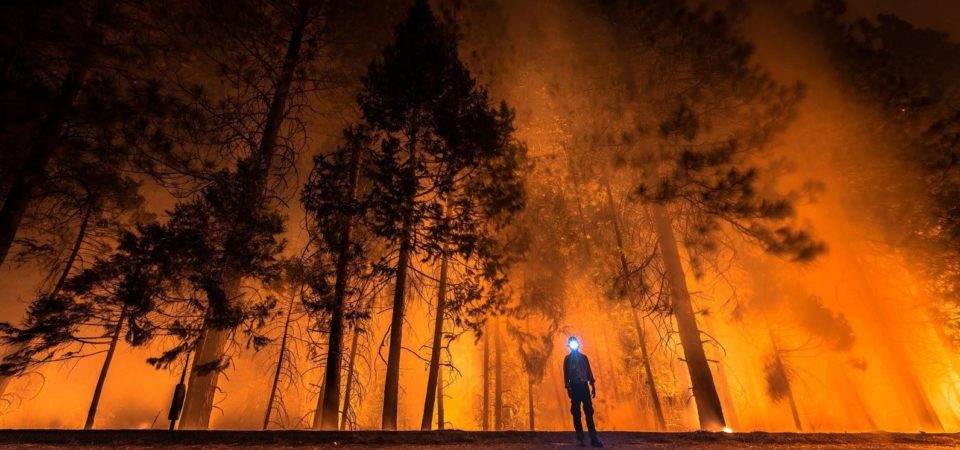I’m afraid I’ll keep getting sucked into this orange world. I was supposed to stop chasing fires two years ago. I did stop! For the first time in six years, I didn’t go to one single wildfire in 2019. But just when you think you’re out, they pull you back in.
The New York Times and National Geographic called. They were working on essential stories on climate migration and a first-person view of the frontlines, respectively. The German publication Der Spiegel and Artnet both asked me to write about how it felt chasing fires once more. In a hazy hotel room, I sat down, and a few raw thoughts poured out. I’ve rewritten and expanded on those paragraphs here for the Environmental Impact exhibition.
I’ll start with the good: the adrenaline. Without that part, we may not even have firefighters. I was amused and somewhat delighted to find, printed in the government-issued FEMA manuals during fire training, the words, ‘You have to be a little crazy to be a firefighter.’ They know. After many days of driving the wrong way towards 30,000 ft towering pyrocumulus clouds, plunging deep into the world of orange chaos, and weaving in and out of fire crews just to get footage, it occurs to me that I must be a little crazy myself. That’s where the good ends.

Returning to fires feels like a cigarette hangover. The kind you get from chain-smoking two full packs of menthols on a boozy night after the worst breakup of your life. The following day, the consequences are inescapable: throbbing headache, skull packed with cotton, and angry wheezing lungs. A blanket of smoke covers the entire western side of the American continent. I call it ‘carbon fog.’ It blocks out the sun. Everywhere. For thousands of miles. San Francisco was 150 miles away from the nearest fires, but the smoke was so thick that automatic lights from the city’s skyscrapers blinked on in the middle of a sunny day. It traveled the distance of a 13-hour flight from Los Angeles to Berlin, where it took European residents by surprise.
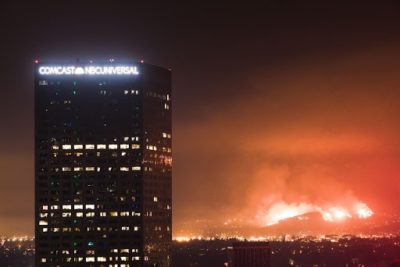
I can’t shake the feeling that the stages of grief: denial, anger, bargaining, sadness, and acceptance are haunting me. Grief does not unfold in a linear way or even one stage at a time, and it’s certainly not a project you finish. The unresolved trauma ebbs and flows through the air around me. It can’t possibly be as ubiquitous as it seems, can it? Then the impotent rage hits. How can we be doing this to the planet!? Blinding anger clouds my vision: or maybe that’s the carbon fog returning. In exchange for throwing bodies at fires, individuals and corporations alike can cling to their lavish pollution-styles. That’s if we haven’t already passed the point where bargaining is possible. Will we follow this path to extinction, or will our ghosts of the future be self-destructive behaviors? After weeks spent chasing down an orange world, it can be easy to slip into accepting despair.
My sense of hope is hanging by a bone-dry twig. It’s twisting in violent wind, wildly oscillating between competing visions of extinction and survival. It’s a war in my mind. I want to see the best in our species, but I’m overwhelmed by the hubris of evolutionary baggage, such as greed and violence. Moments of light puncture the misery with futuristic fantasies that humans could be the beginning of the first billion-year species, but the contradiction between light and dark is disorienting. I step back to get my bearings, only to beat myself up for failing to plunge into blind optimism.
I lost almost all hope for the final two years of shooting my video art film, California on Fire (it took five years to create). I don’t want to return to that place, yet I feel a responsibility to do so. How many artists are behind active fire lines? There can’t be many. There shouldn’t be many. You’d have to be a little crazy, right? I’ll go to fires if there’s an excellent reason, and with any luck, when the darkness seeping into my mind becomes unbearable, I’ll be able to leave.
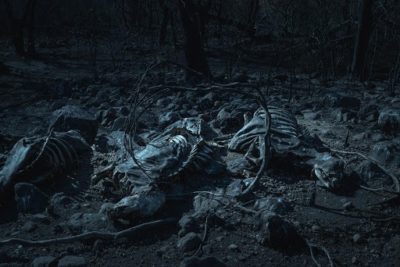
We are in a toxic relationship with orange. Our skies are orange. So is our president. Orange continues to spread across the world like a disease. Even if the USA chooses blue by the end of the year, the conditions leading to this tainted world will remain. It will continue to shade the globe far longer than bronzer on skin.
This relationship isn’t working out. It’s time for a breakup.
I am really sick of orange.
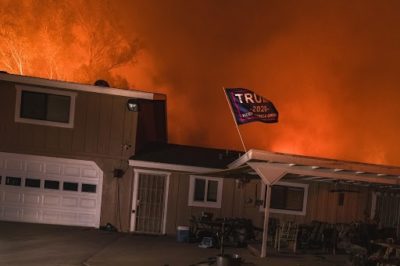
We have three months to go until 2021, and as I write this, 24 active fires are burning in California. This year, four million acres and 9,200 structures have burned at a cost of $1.5 billion. Worse still, 31 people – including three firefighters – have lost their lives. Comparatively, the second-largest year on record burned less than half that figure, at 1.9 million acres. That was just two years ago, in 2018. Since 2000, California has seen 17 of 20 of the largest fires in state history. Further, 19 of 20 of the hottest years on record have occurred globally. Megafires are increasingly popping up around the planet just above and below the equator. It is not a problem unique to California by any stretch.
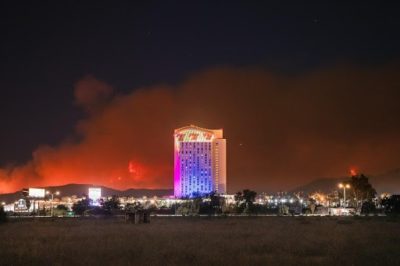
The good news is we know how to reverse the effects of climate change. The question is, will we?
Carbon dioxide removal technologies have taken leaps and bounds in recent years, including direct air capture, which removes co2 from the air and converts it into clean-burning fuel for existing vehicles, outlined in HBO’s Ice on Fire along with several other solutions. It will take worldwide, government-level spending to scale up these technologies. Everyone will have to get on board: left, right, rich, poor, and everything in between.
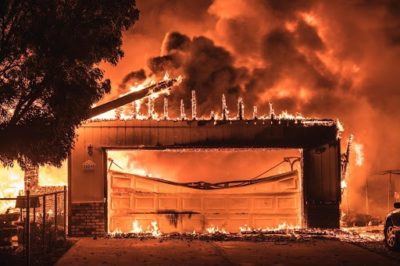
Natural disasters have no respect for class, but please note they disproportionately affect people of color and all other minorities first and worst. This is the intersection of the fight against systemic racism and climate justice. Not only are technologies evolving rapidly to rise to the occasion, so too are diverse thought leaders, researchers, and artists working in many different fields. For example, All We Can Save is a new book highlighting climate solutions from over 40 female contributors at the forefront of the climate movement. It’s a breath of fresh air, man.

Even when our problems with the environment and politics feel impossibly large, we must persevere and act as though it is possible to make things better. It’s important to remind ourselves of this perspective. The alternative is to give up and let the orange cover everything.
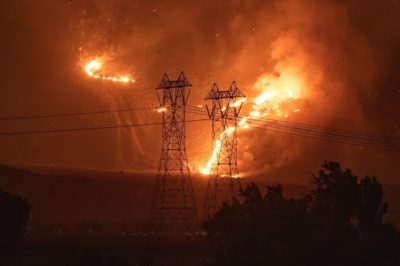
Additional editing by Alexandra Cheney, Athina Kontos, Elin Rowland, Nancy Baker Cahill, & Lucy Davidson
Jeff Frost grew up in a remote corner of Utah hiking with his grandfather and has lived in southern California for the last 22 years. Time and sound are his two primary mediums, often expressed through a number of sub-mediums including painting, photography, video, and installation. Nearly all of the above are combined into short films exploring themes on the spectrum of creation and destruction. Frost’s work has been shown at the California Museum of Photography (UCArts), Museum of Art & History Lancaster (MOAH), Museum of Sonoma County, Palm Springs Art Museum, the Center for European Nuclear Research (CERN), Los Angeles International Airport (LAX), and many others. In 2020 his video art projects, California on Fire and GO HOME won numerous awards at international film festivals including the Clermont-Ferrand Intl Film Festival and ÉCU The European Independent Film Festival. He was selected for the Nordic LA residency at the ACE Hotel & the FBAiR Los Angeles residency programs in 2019. He performed a soundart set at the Desert Daze music festival in 2019. He was both a producer and subject of the 2017 Netflix docuseries, Fire Chasers. That same year he contributed to the National Geographic series, One Strange Rock. He has been featured in numerous online publications and TV interviews such as PBS Newshour, TIME Magazine, Artnet, and American Photo. He has spoken at the Seattle Art Fair, University of Southern California, Palm Springs Art Museum, Orlando Museum of Art, Snap! Orlando, and photoLA. See his work at frostjeff.com
Jeff Frost is represented in the traveling museum exhibition, ENVIRONMENTAL IMPACT II, with four photographs:
- 20170718 Detwiler Fire Here Is the Church 38mm d800e-1001
- 20150915 Valley Fire Lone Survivor 70mm d800e-1004
- 20160623 LakeFire Milky Way Overlook 35mm d800e-8147
- 20171118 Atlas Fire Cattle I 24mm a7rii-1008
ENVIRONMENTAL IMPACT II, produced by David J. Wagner, L.L.C., may be viewed online at:
https://www.davidjwagnerllc.com/Environmental_Impact-Sequel.html
This blog is part of MAHB’s ENVIRONMENTAL IMPACT II series, a travelling museum’s exhibition.
The MAHB Blog is a venture of the Millennium Alliance for Humanity and the Biosphere. Questions should be directed to joan@mahbonline.org
The views and opinions expressed through the MAHB Website are those of the contributing authors and do not necessarily reflect an official position of the MAHB. The MAHB aims to share a range of perspectives and welcomes the discussions that they prompt.
